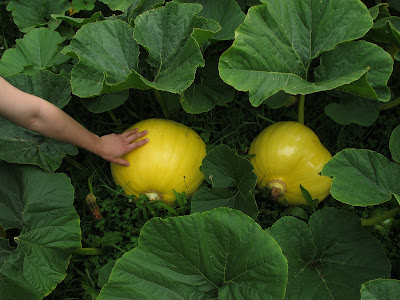This past summer I grew a few winter squash (Cucurbita maxima) plants of the famous Atlantic Giant variety. The seed was first generation from 'Kings Seed' so my chances of producing an 800+ kg fruit were next to none. However, the plants did manage to produce two big squashes. I saved seed from the largest of these and will see if I can get even more gargantuan fruit next year.
Squashes are comprised of varieties and hybrids from about(?) four species of cucurbits: C. maxima, C pepo, C. moschata and C. mixta. To clarify: here I employ the term "winter squash' following North American usage, which divides squashes into two broad categories - summer and winter. Summer squashes are those harvested when immature including zucchini (forms of C. pepo), whereas winter squashes are those harvested after maturity, often entailing the hardening of their fruit's skin, and are commonly stored for eating during... winter.
Notice I have avoided the word 'pumpkin' here. So what is a pumpkin? Well, the term pumpkin is often used interchangeably with winter squash here in the Antipodes, but in the strict sense refers to particular varieties (apparently of all four species) of winter squash that typically have orange skins, creased longitudinally.
Atlantic Giant squash are commonly referred as 'pumpkins', and they well might be. Except, in the Wikipedia article on 'Big Max', another giant variety of winter squash, we gentle readers are informed that these giant 'hybrids' (scare quotes indicate I have no idea what concept of hybrid is being used here - probably not between species) are not true pumpkins, but 'squash-like' pumpkins. Confused? You are not alone. If anyone out there has a more developed understanding of the situation, or cares enough to trawl the literature, feel free to set the record straight in the comments.
Squash fruit are actually large berries. They are a special type distinguished by their hard rinds and given the name 'pepos' (sing. = pepo). Pepos are common among but not exclusive to cucurbits.
My cultivation involved digging 800cm deep pits the previous winter and filling them with green waste, leaves and manure. A great deal of horse and alpaca manure. When the time came to plant I covered the composted materials with a layer of soil, so as not to burn the seedling's roots. As the vines were growing I supplemented with more manure and nitrogenous wastes in the form of a tea. Next year I will experiment with switching to a potassium heavy fertiliser (maybe comfrey based) after fruit set to encourage their growth.
At the point of harvest I had these large inedible pumpkins that were almost too heavy to lift. So what to do?
I present my solution below (music = Drain by Autechre from the Peel Session CDEP)



No comments:
Post a Comment